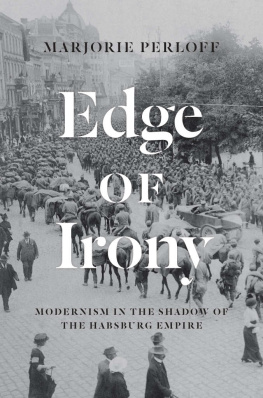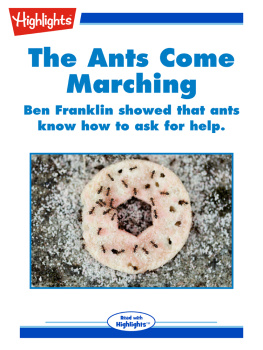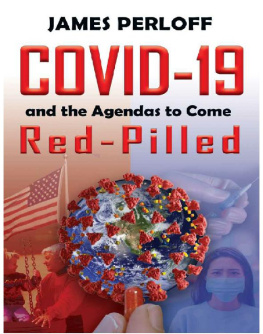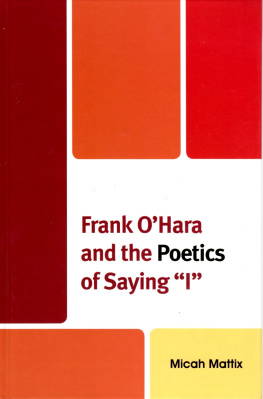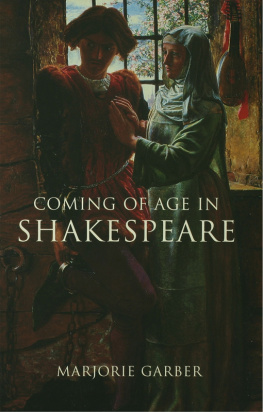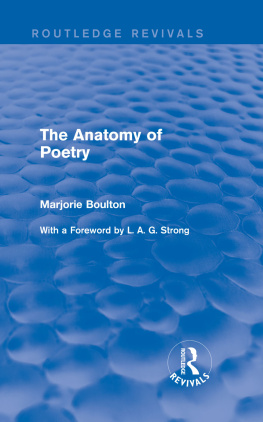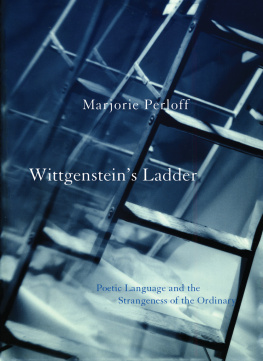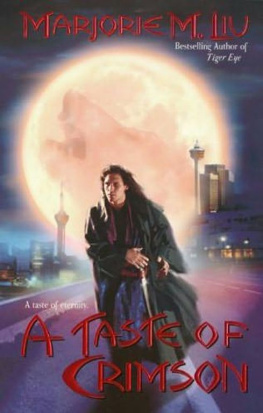Marjorie Perloff - Infrathin An Experiment inMicropoetics.
Here you can read online Marjorie Perloff - Infrathin An Experiment inMicropoetics. full text of the book (entire story) in english for free. Download pdf and epub, get meaning, cover and reviews about this ebook. year: 2021, publisher: University of Chicago Press, genre: Detective and thriller. Description of the work, (preface) as well as reviews are available. Best literature library LitArk.com created for fans of good reading and offers a wide selection of genres:
Romance novel
Science fiction
Adventure
Detective
Science
History
Home and family
Prose
Art
Politics
Computer
Non-fiction
Religion
Business
Children
Humor
Choose a favorite category and find really read worthwhile books. Enjoy immersion in the world of imagination, feel the emotions of the characters or learn something new for yourself, make an fascinating discovery.
- Book:Infrathin An Experiment inMicropoetics.
- Author:
- Publisher:University of Chicago Press
- Genre:
- Year:2021
- Rating:4 / 5
- Favourites:Add to favourites
- Your mark:
- 80
- 1
- 2
- 3
- 4
- 5
Infrathin An Experiment inMicropoetics.: summary, description and annotation
We offer to read an annotation, description, summary or preface (depends on what the author of the book "Infrathin An Experiment inMicropoetics." wrote himself). If you haven't found the necessary information about the book — write in the comments, we will try to find it.
Infrathin An Experiment inMicropoetics. — read online for free the complete book (whole text) full work
Below is the text of the book, divided by pages. System saving the place of the last page read, allows you to conveniently read the book "Infrathin An Experiment inMicropoetics." online for free, without having to search again every time where you left off. Put a bookmark, and you can go to the page where you finished reading at any time.
Font size:
Interval:
Bookmark:
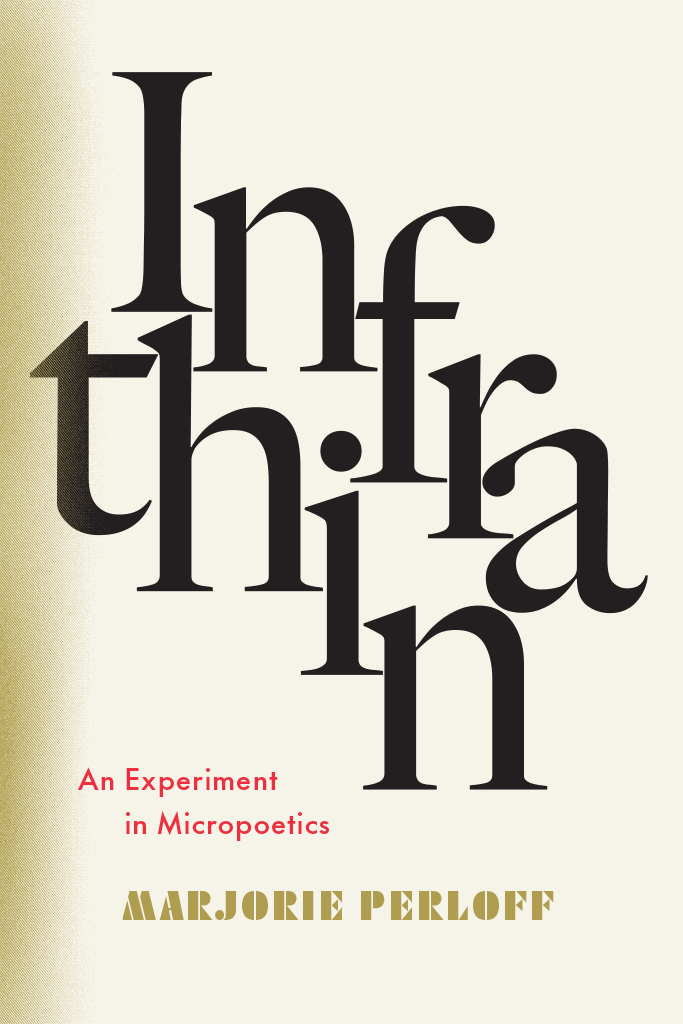
Marjorie Perloff
The University of Chicago Press
Chicago and London
The University of Chicago Press, Chicago 60637
The University of Chicago Press, Ltd., London
2021 by The University of Chicago
All rights reserved. No part of this book may be used or reproduced in any manner whatsoever without written permission, except in the case of brief quotations in critical articles and reviews. For more information, contact the University of Chicago Press, 1427 East 60th Street, Chicago, IL 60637.
Published 2021
Printed in the United States of America
29 28 27 26 25 24 23 22 21 20 1 2 3 4 5
ISBN-13: 978-0-226-71263-5 (cloth)
ISBN-13: 978-0-226-79850-9 (paper)
ISBN-13: 978-0-226-71277-2 (e-book)
DOI: https://doi.org/10.7208/chicago/9780226712772.001.0001
Library of Congress Cataloging-in-Publication Data
Names: Perloff, Marjorie, author.
Title: Infrathin : an experiment in micropoetics / Marjorie Perloff.
Description: Chicago : University of Chicago Press, 2021. | Includes bibliographical references and index.
Identifiers: LCCN 2021007593 | ISBN 9780226712635 (cloth) | ISBN 9780226798509 (paperback) | ISBN 9780226712772 (ebook)
Subjects: LCSH: Poetics. | Poetry.
Classification: LCC PN1042 .P38 2021 | DDC 808.1dc23
LC record available at https://lccn.loc.gov/2021007593
 This paper meets the requirements of ANSI / NISO Z39.48-1992 (Permanence of Paper).
This paper meets the requirements of ANSI / NISO Z39.48-1992 (Permanence of Paper).
For Craig Dworkin
Toward an Infrathin Reading/Writing Practice
Stein, Duchamp, and the Illegible Portrait
A Rehearsal for Concrete Poetry
The Invention of Pounds Canto Page
Wallace Stevenss Rock, Susan Howes Quarry
From John Ashbery to Charles Bernstein and Rae Armantrout
Poeticity in Becketts Text-Soundings
The Paragrammatic Potential of Traditional Verse
Marcel Duchamp, Inframince (1934)
Marcel Duchamp, Fountain (1917/1964)
Alfred Stieglitz, Fountain by R. Mutt (1917)
Philippe Solari, Tomb of mile Zola (1904)
Man Ray, Marcel Duchamp as Rrose Slavy (ca. 192021)
Man Ray, Rrose Slavy (1921)
Marcel Duchamp, Fresh Widow (1920/1964)
Marcel Duchamp, Belle Haleine, Eau de Voilette (1921)
Marcel Duchamp, Why Not Sneeze Rrose Slavy? (1921)
Man Ray, Portrait of Marcel Duchamp (192021)
Marcel Duchamp, In Advance of the Broken Arm (1964)
Marcel Duchamp, The Bride Stripped Bare by Her Bachelors, Even (The Large Glass) (191523)
Marcel Duchamp, Bottle Rack (Porte-Bouteilles) (195859)
Marcel Duchamp, Mona Lisa (L.H.O.O.Q) (1919)
Marcel Duchamp, Some French Moderns Says McBride (1922)
Ian Hamilton Finlay, ring of waves (1968)
Ian Hamilton Finlay, The Seas Waves (1970)
Ezra Pound, Canto 79, The Pisan Cantos (1948)
Ezra Pound, Canto 80, The Pisan Cantos (1948)
Charles Olson, On first Looking out through Juan de la Cosas Eyes (1960)
Ezra Pound, Canto 74, The Pisan Cantos (1948)
Susan Howe, Pavilion in Elizabeth Park, Winter (2015)
Susan Howe, Pavilion in Elizabeth Park, Summer (2015)
W. B. Yeats, First Draft of The Wild Swans at Coole (before 1917)
Can one make works that are not works of art? Of course one canthink of the now iconic urinal called Fountainbut Marcel Duchamp, who posed that question and made that fountain, was quick to add that it does not follow that anyone can be an artist. Many of us, for instance, write poetry at some point in our lives, but our poems, written for this or that occasion, are not likely to interest anyone outside our personal circle. Here, for example, is a limerick recently included in an email from my friend Christian Bk, who had been teaching in Darwin (Australia) and was touring the Irish countryside with two old Canadian buddies, Gary Barwin and Gregory Betts:
There once was a Christian from Darwin
And a Wandering Jew named Barwin
Who, to Limerick with Betts,
Got whiskey, comma, Tourettes:
Feck ye! said all three to the barman.
As it happens, Barwin, Betts, and Bk are all poets, the last named quite a celebrated one. But this little limerick, tossed off for fun on their road trip, is more or less a throwaway, although Bks potential biographers just might take an interest in the power of whiskey to simulate Tourette syndrome.
But what about those phrases and lines of poetry that continue to haunt us, including some of Bks own, like A pagan skald scans a dark saga in Eunoia? Lines like Absent thee from felicity awhile, or To comprehend a nectar / requires sorest need, or Till human voices wake us and we drown? As a child in Vienna, I loved reciting the German lyric Kennst du das Land wo die Zitronen blhn / Im dunkeln Laub die Goldorangen glhn, even though I had no idea what these lines meant or why the mysterious child Mignon expresses such longing for lemons and golden oranges in Goethes Wilhelm Meister. Reading great poetryI use the adjective advisedly, knowing full well that it is taboo at our cultural momentis, I believe, one of the great (theres that word again) human pleasures. However strongly we may disagree as to the greatness of this or that poem or its place in a potential poetry canon, most readers who have bothered to open this book in the first place will concur that poetry matters. And they will also grant, I believe, that poetry is, in Ezra Pounds now familiar words, news that stays news. Which is to say that poetry cant just be read and deleted like the most recent Instagram; it demands to be reread.
This book is an attempt to convey to a nonspecialist audience what it is, from my perspective, that makes poetry with a capital P so captivating and indispensable. The choice of poetsmost of my poets are familiar Modernistsis much less important than the example of a possible methodology. That methodology is by no means some abstract theoretical model; rather, it is a practice, based on my own sense of what a super-close readinga reading for the visual and sonic as well as the verbal elements in a text, for the individual phoneme or letter as well as the larger semantic importcan do for us. Micropoetics, let me add, is by no means Art for Arts Sake: the contexthistory, geography, cultureof a given poems conception and reception are always central.
Infrathin was begun some years before the coronavirus struck and is being completed in the sixth month of the Plague Year 2020. Given the current crisis, talk about Ezra Pounds page design or Susan Howes phonemic clusters may seem frivolous; then again, our moment may well be the very time-out we need to return us to the charm of poetry. At the very least, the reading of poetry can be an antidote to the unbearable news cycle and Twitter feed. To paraphrase the brilliant opening statement in Karl Krauss Third Walpurgisnacht (written shortly after Hitler came to power in Germany), About Trump, I have nothing to say.
The scansion used throughout this book is an adaptation of the traditional one used for English metrics in standard textbooks on the subject. Primary stresses are marked by an acute accent, secondary stresses by a circumflexas in compounds like blckbrd
Next pageFont size:
Interval:
Bookmark:
Similar books «Infrathin An Experiment inMicropoetics.»
Look at similar books to Infrathin An Experiment inMicropoetics.. We have selected literature similar in name and meaning in the hope of providing readers with more options to find new, interesting, not yet read works.
Discussion, reviews of the book Infrathin An Experiment inMicropoetics. and just readers' own opinions. Leave your comments, write what you think about the work, its meaning or the main characters. Specify what exactly you liked and what you didn't like, and why you think so.


